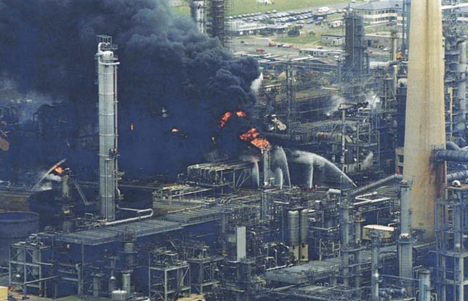The Weekly Reflektion Week 12/2021
With extreme weather seemingly becoming more regular, how robust our operations to the changing conditions.
Is your inspection and maintenance program achieving the aim of a safe and effective operation? Do you err on the side of caution?

A lightning strike on the crude distillation unit at the Milford Haven refinery in South Wales caused a fire, and all other process units except the fluid catalytic cracker (FCC) were shut down. Approximately 5 hours later, during a cascade of alarms and while attempts were being made to restart the wet gas compressor, an outlet line on the flare knockout drum failed, releasing 20 tonnes of hydrocarbons. This gas cloud found an ignition source 110m away and exploded injuring 26 people working at the plant, fortuitously no one was killed. The explosion occurred on a Sunday afternoon when few were working, and those who were there, were located away from the blast site. The explosion damaged the flare relief system, so the fires were allowed to burn for 2 ½ days since it was not possible to de-pressure the process systems. Properties in the nearest town 3 km away were also damaged. The refinery was shut down for 9 weeks and it took another 9 weeks to restore production to full capacity.
The investigation found that hydrocarbon liquid was being continuously pumped into a vessel with the outlet valve closed. The valve indication on the control system showed open. Hydrocarbons were venting through a pressure relief system to the flare, but the flare system was not designed to cope with this flowrate. The hydrocarbon liquid overflowed to the FCCU flare knockout drum where a corroded elbow on the knockout drum vapour outlet line failed due to the high pressure created.
Inadequate maintenance was the cause of the valve being in the wrong position. The inspection of the outlet pipe was found to be inadequate in terms of both number and location of the inspection points, and the inquiry recommended that inspection programs should err on the side of caution.
It was also found that an earlier plant modification on the FCCU flare knockout drum automatic pumpout system had been done without an assessment of the potential consequences. Safety issues identified during the design stage were not considered in the construction and operation of the modified system.
During the incident, the number of alarms generated in the control system made it difficult to assess which were the most important. The process graphics did not give the overview necessary to facilitate troubleshooting. How is the alarm handling and the graphics on your systems?
With many aging facilities there is often a requirement to cut down on operating costs. How do you ensure that the inspection and maintenance programs are adequate? When modifying systems, how is your management of change process, and does it build a new risk picture that can be used to make decisions?
